How to Roast Vegetables Perfectly

Discover the magic of making vegetables irresistible through roasting. Roasting vegetables changes simple veggies into flavorful delights. It creates a beautiful crunch outside and keeps them juicy inside. This method works for both hearty root veggies and tender greens. Learning how to roast vegetables perfectly will take your meals to the next level.
To start, heat your oven to 425°F and add a bit of culinary magic. This high heat gives veggies a golden-charred finish, from squash to bell peppers. Don’t just steam or boil your sides. Roasting brings out amazing textures and flavors. So, grab your spatulas and let’s heat those ovens. We’re on our way to mastering the art of roasting!
Key Takeaways
- Discover the transformative power of roasting for creating sweet, caramelized flavors.
- Choose the best vegetables from tender zucchini to hearty root varieties for roasting.
- Learn the importance of high heat – 425°F for ideal crispy exteriors and soft interiors.
- Understand proper vegetable preparation and seasoning to achieve roasting perfection.
- Explore the nutritional benefits and versatility of incorporating roasted vegetables into your meals.
- Gain insight into roasting times tailored for different vegetable types for optimal results.
- Tips on storing and reheating to maintain the roasted goodness for days to come.
Why Roasting Vegetables is a Game Changer
Roasting veggies makes them tastier and keeps their nutrients. It’s the best way to bring out their natural flavors. By using roasting tips, you can make your meals both delicious and healthy.
Benefits of Roasting
Roasting makes veggies taste better. It does this through caramelization and the Maillard reaction. These processes brown the veggies, making them rich and flavorful.
Unlike boiling, high-heat roasting boosts taste. It creates a delightful char. Roasting is more than just healthy cooking. It makes every bite the best it can be.
Versatility of Roasted Vegetables
Roasting works for all kinds of veggies. From carrots that cook slowly to quick zucchini, all get cooked well. It suits many diets, making it perfect for anyone.
Health Benefits of Roasting
Roasting keeps the vitamins and minerals in your veggies better than boiling. It’s great for a nutrient-rich diet. Using the right tips ensures your veggies are full of flavor and health benefits.
Anyone can improve their meals with roasted veggies. They boost flavor, keep nutrients, and are versatile. That’s why roasting is a key skill in the kitchen.
Choosing the Right Vegetables for Roasting
To make delicious roasted veggies, knowing the right roasting temperature is key. Picking the right vegetables also affects your dish’s texture and flavor.
Best Seasonal Choices
Choosing veggies based on the season is crucial. Root vegetables like beets and carrots are great in cooler seasons. They caramelize beautifully when roasted. In summer, zucchini and bell peppers make bright, tasty side dishes.
Root vs. Leafy Vegetables
Root vegetables, like potatoes and sweet potatoes, need longer to cook. They become crispy outside and soft inside at high temperatures. Leafy greens, such as spinach or kale, roast quickly. Keep an eye on them to avoid overcooking.
Sturdy vs. Delicate Veggies
The strength of vegetables affects roasting time and temperature. Squash and cauliflower, which are sturdy, can roast longer for more flavor. Delicate vegetables like tomatoes and asparagus need less time. This prevents them from overcooking.

| Vegetable Type | Estimated Roasting Time at 425°F |
|---|---|
| Root vegetables (carrots, potatoes) | 30-45 minutes |
| Winter squash (butternut squash) | 20-60 minutes |
| Crucifers (broccoli, Brussels sprouts) | 15-25 minutes |
| Soft vegetables (bell peppers, zucchini) | 10-20 minutes |
| Thin vegetables (asparagus, green beans) | 10-20 minutes |
| Onions | 30-45 minutes |
| Tomatoes | 15-20 minutes |
Perfectly roasted veggies come from not just the heat, but also the right vegetable choice. Keep these tips and the ideal roasting temperatures in mind. You’ll create tasty, healthy dishes in no time.
Essential Tools for Roasting Vegetables
Roasting vegetables is a cooking skill that needs both creativity and the proper equipment. If you’re roasting a mix of veggies or just trying it out, having good tools is key. The tools you use can either make your dish amazing or ruin it.
Optimal Baking Sheets and Pans
For great roasted veggies, starting with the best baking sheets and pans is crucial. Heavy-gauge, rimmed baking sheets are best. They hold different veggies well and prevent them from falling off. Plus, they help heat spread evenly, stopping some parts from cooking too much or too little.
If you’re cooking thick or hard veggies, a strong cast iron skillet or stoneware dish is best. They help make a crispy outside and a soft inside.
Must-Have Utensils
You need more than just pans and sheets for a great dish. Here’s a list of must-have utensils for easier and better roasting:
- Large mixing bowl: Great for mixing vegetables with oil and spices before cooking.
- Sharp knife: Makes cutting vegetables evenly easier, which helps them cook evenly.
- Vegetable peeler: Quickly peels skins off veggies like carrots or butternut squash.
- Spatula or tongs: Helps turn vegetables so they brown on all sides.
- Measuring spoons: Lets you measure spices and oil accurately to keep flavors just right.
Using the Right Oven
Having a good oven is very important for roasting veggies well. Your oven should keep high temperatures steady everywhere. The best temperatures for roasting most vegetables are between 375F to 425F degrees. 400F degrees is often just right for getting that beautiful golden color.
Checking your oven’s temperature with a thermometer can help prevent uneven cooking. It makes sure every batch of veggies turns out just right.
With the best cookware and utensils, you’re on your way to success in the kitchen. Your veggies will come out perfectly cooked. Plus, the cooking process will be smoother, faster, and more fun.
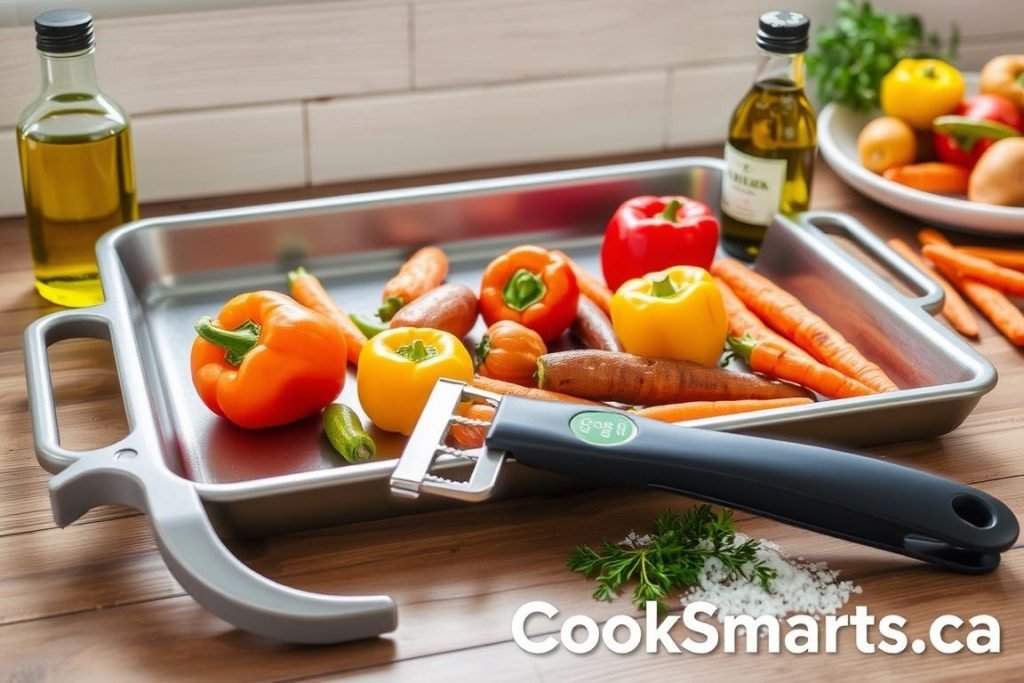
Preparing Your Vegetables for Roasting
Starting your journey to perfect roasted veggies begins with the right prep. It’s not just about washing and cutting. Proper prep boosts both flavor and texture, making roasting veggies a joy.
Washing and Cutting Techniques
First, wash your veggies well to get rid of dirt or residues. Peeling is up to you and depends on the veggie. For example, carrots and potatoes taste great with their skins on, adding texture and nutrients.
Make sure to cut your vegetables into similar sizes. This is key because it helps them cook evenly. No one wants some pieces mushy and others too hard. Also, getting them dry is important. Remember, water stops them from getting crispy. After drying, you’re ready to season them.
Seasoning Fundamentals
Good seasoning turns plain veggies into something special. Start with a mix of olive oil, kosher salt, and black pepper. This simple combo boosts the veggies’ natural tastes. If you like things a bit spicier, try adding garlic powder, paprika, or a dash of cayenne.
Marinating for Extra Flavor
Marinating your veggies can add even more flavor. Try a light vinaigrette made with olive oil, vinegar, salt, pepper, and herbs like thyme or rosemary. Let them marinate for at least 30 minutes. This way, they soak up all that tasty goodness, making your dish extra flavorful.
Preparing your veggies right is the first step to a delicious and nutritious meal. Following these roasting tips will help you get perfect roasted veggies every time. The effort you put into prep sets the stage for tasty results.
| Seasoning Ingredient | Recommended Amount |
|---|---|
| Olive Oil | 2 tablespoons per pound of vegetables |
| Kosher Salt | 1 teaspoon per pound of vegetables |
| Black Pepper | 1/2 teaspoon per pound of vegetables |
| Optional Spices (cumin, paprika) | 1/2 teaspoon per pound of vegetables |
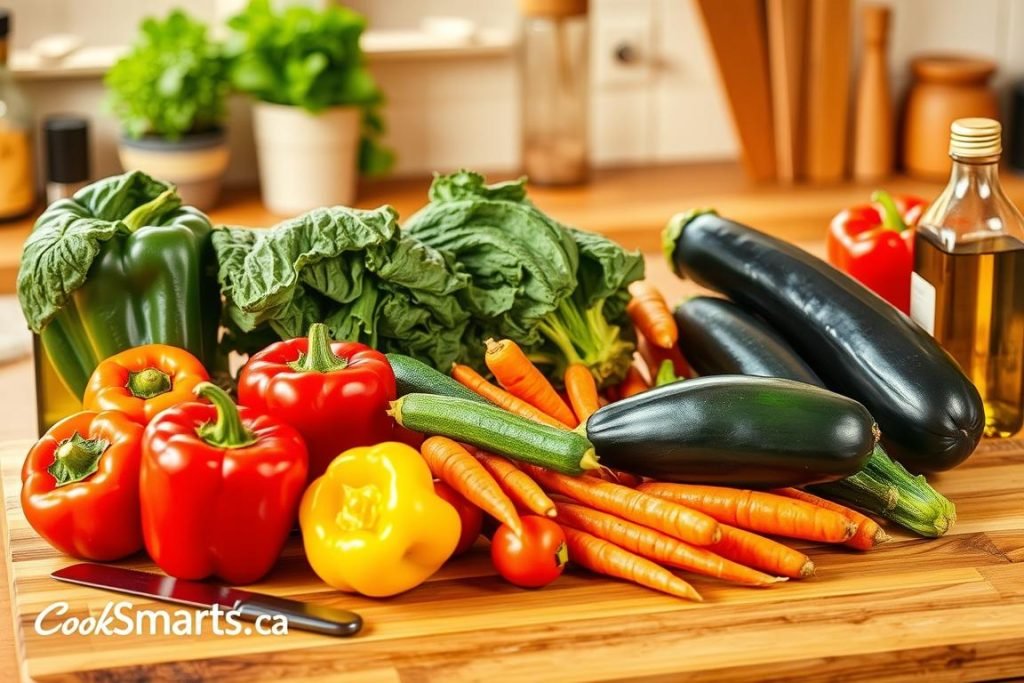
The Importance of Temperature
Knowing the best roasting temperature is key for oven-roasted vegetables. The right temperature helps your vegetables cook fully. It also helps get that tasty caramelization that makes a roasted dish great.
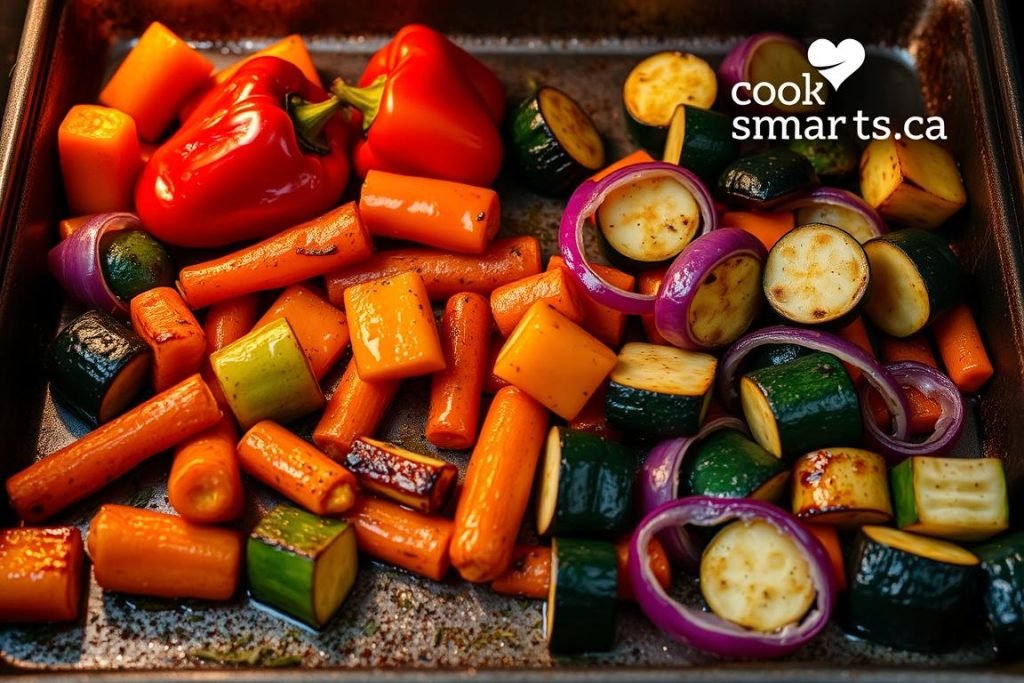
Understanding Oven Temperature
The best roasting temperature is between 425-450 degrees Fahrenheit. But, you might need to adjust based on the vegetable type. For example, dense root vegetables like carrots and potatoes cook well at high heat. This helps them cook evenly and get a crispy outside.
Using a convection setting makes them even crispier. It does this by blowing hot air around, cooking them evenly on all sides.
Preheating: Why It Matters
Don’t skip preheating your oven when roasting vegetables. Preheating makes sure your veggies start cooking as soon as they’re in the oven. This helps them cook fast and not turn soggy. Instead, they get a nice crispy outside.
With the right oven temperature and preheating, you can make amazing oven-roasted vegetable dishes. They’ll be healthy, tasty, and have that perfect crisp. The right temperature makes all the difference in cooking.
Timing: How Long to Roast Vegetables
Learning to roast vegetables the right way starts with knowing how long each kind takes. Whether you follow a recipe or make your own mix, timing is key. It helps get that perfect crispy outside and soft inside.
General Timing Guidelines
Different veggies cook at different speeds when roasted. Dense root veggies, like sweet potatoes and carrots, take longer. For example, sweet potatoes and Brussels sprouts roast well in about 35 minutes at 425°F. But, soft vegetables like zucchini and snap peas need less time, about 10 minutes, so they don’t get mushy.

Signs Your Vegetables Are Done
When you can pierce your veggies with a fork but they’re still a bit firm, they’re done. They might also have slight charred edges. This gives a nice crunch and taste. If in doubt, letting them roast a bit longer isn’t bad. They’ll still taste great and have a good texture.
Checking them often and stirring sometimes helps cook everything evenly. This is especially true when roasting different veggies together.
The secret to perfect roasted veggies includes a hot oven, correct timing, and patience. Let the flavors develop fully. Enjoy your roasting!
Mastering the Art of Seasoning
To make healthy roasted vegetables taste great, you have to know how to season them. This means choosing the right oils. Then, picking the best spices and herbs to bring out the veggies’ flavors.
Best Oils to Use
Selecting the right oil is important for taste and health. Olive oil is a top choice because of its taste and it’s good for cooking at high temperatures. Avocado oil is also great. It can handle the heat and adds a smooth flavor.
Creative Spice Combinations
To make your veggies taste amazing, think about your spice mix. Start with basics like sea salt, pepper, and garlic powder. For more excitement, try adding smoked paprika or cumin. Culinary pros like Bobby Flay suggest using more herbs and spices. They say doing this boosts flavors without extra calories.
Adding Fresh Herbs
Adding fresh herbs makes roasted veggies taste and look better. Rosemary and thyme are perfect for high heat. They release oils that flavor your veggies. After cooking, add fresh parsley or cilantro. This step enhances taste and makes your dish look great.
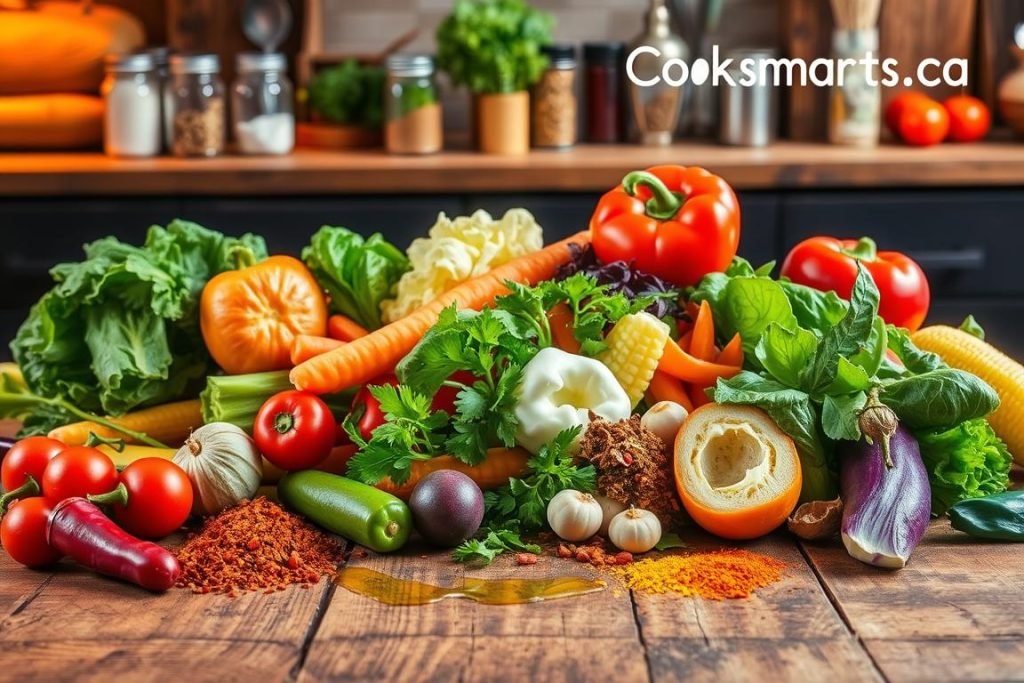
Understanding seasoning can make simple veggies into something special. The trick is to balance and be creative. Let each seasoning enhance the veggies without hiding their natural taste.
One-Pan Roasting: A Simple Approach
One-pan roasting simplifies cooking and teaches you to roast vegetables perfectly. It cuts down on cleanup and boosts flavors, making easy veggie roasting easy for anyone. Using only one pan lets you try different veggies and spices for tasty, healthy dishes.
Benefits of One-Pan Meals
One-pan meals are all about convenience and saving time. Just by using one pan for a variety of vegetables, you get a nutritious meal with less effort. The flavors mix well while roasting, creating a dish that’s rich in taste and texture.
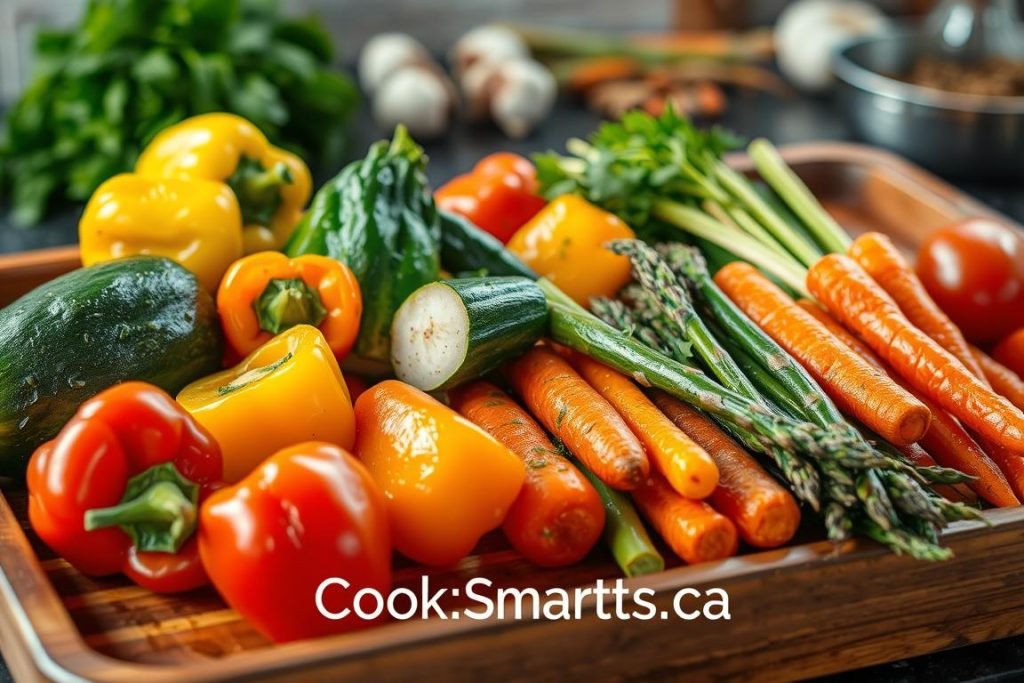
Recipe Ideas for One-Pan Roasted Vegetables
Try a mix of sweet potatoes, carrots, parsnips, and Brussels sprouts for dinner. Heat your oven to 425 degrees F for the best caramelization. Coat your veggies in olive oil, smoked paprika, salt, and pepper for maximum flavor and crispiness.
The table below provides nutritional info and other details for a simple one-pan roasted vegetable dish:
| Nutritional Values | Details |
|---|---|
| Calories | 104 per serving |
| Prep and Cook Time | 45 minutes (10 minutes prep, 35 minutes cook time) |
| Number of Servings | 10 servings |
| Key Ingredients | Sweet potato, broccoli, olive oil, paprika, garlic, asparagus, cherry tomatoes |
This one-pan easy veggie roasting method makes cooking simpler. Plus, it offers meals that are good for you, low in calories, and full of taste.
Creative Add-Ins for Roasted Vegetables
To make your roasted vegetable recipes better, try adding something extra. Use special ingredients towards the end of roasting. They boost the taste and nutrition. Here are some ideas to spice up your easy veggie roasting.
Cheese Options for Roasting
Make your veggies more delicious by adding cheese before they’re done baking. You could use sharp cheddar for strong flavor or mozzarella for a soft touch. Gruyere adds a nutty taste, while Parmesan makes things crispy. These cheeses make the veggies creamy and sweet.
Nuts and Seeds for Crunch
If you like crunchy food, add some nuts or seeds. They add a nice texture and are good for you. Try almonds, walnuts, or sunflower seeds right before you eat. They make the veggies taste even better with their nutty flavor.
Accompaniments like Sauces
Add some sauce to your roasted veggies to make them tastier. Balsamic vinegar brings sweetness and tartness. Homemade pesto adds a fresh taste. A bit of lemon or lime makes your dish brighter and more enjoyable.
These add-ins make your roasted vegetable recipes more exciting. They turn simple meals into special treats and are healthier too. Everyone will love your easy veggie roasting with these tips.

Roasting Different Types of Vegetables
Roasting vegetables correctly can make your cooking stand out. It brings out their natural sweetness and gives them a crispy finish. With different vegetables like root veggies or peppers, knowing how to roast them is important. This ensures they taste great.
Starchy Vegetables: Potatoes and Squash
Starchy veggies like potatoes and squash need high heat. This helps break down their tough textures and makes them sweet. Roast these at 425 degrees F for the best texture. Potatoes take about 30-40 minutes, and butternut squash roasts in 25-30 minutes.
Cruciferous Veggies: Broccoli and Cauliflower
Broccoli and cauliflower do well at high temperatures too. This method chars their edges but keeps the inside tender. Cook them at 425 degrees F. They should be ready in 20-25 minutes. Make sure the florets are the same size so they cook evenly.
Colorful Options: Bell Peppers and Carrots
Bell peppers and carrots bring color and taste to your meals. Roast bell peppers for 15-20 minutes and carrots for 20-30 minutes at 425 degrees F. This heat softens the carrots and chars the bell peppers slightly. It really brings out their flavors.
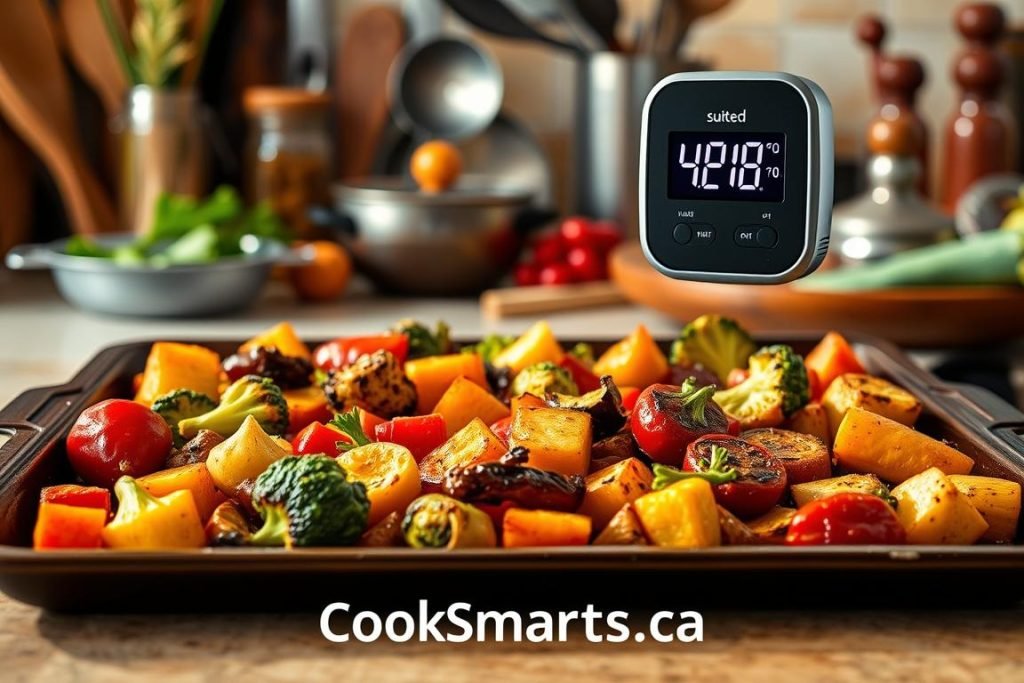
| Vegetable | Roasting Time | Temperature |
|---|---|---|
| Potatoes | 30-40 minutes | 425 degrees F |
| Butternut Squash | 25-30 minutes | 425 degrees F |
| Broccoli | 20-25 minutes | 425 degrees F |
| Cauliflower | 20-25 minutes | 425 degrees F |
| Bell Peppers | 15-20 minutes | 425 degrees F |
| Carrots | 20-30 minutes | 425 degrees F |
By following these tips, you can cook veggies perfectly. This way, they keep most of their nutrients. Getting the cooking time and temperature right is key for delicious vegetables. The best roasted dishes come from not just good ingredients, but also how you cook them.
Storage and Reheating Tips for Roasted Vegetables
Learning to roast vegetables well is a great skill. It helps long after the first meal. People loved the idea of preparing them in bulk, going by emails and comments from a year ago. By roasting lots on the weekend, you make weeknights easier. This way, adding healthy veggies to any dinner is a breeze.
Storing Leftovers Safely
For storage, being consistent is important. Using two 9″ x 13″ containers helps keep your veggies organized in the fridge. After cooling, you can store roasted veggies in the fridge for up to 5 days. This keeps them fresh and nutritious.
Best Practices for Reheating
For reheating, some methods are better than others. Heating them in the oven at 350°F can make them crisp again. Check them after 10 minutes. Or, reheating in a cast iron pan with some olive oil or butter can make them taste fresh. This way, even picky eaters will want more.
Serving Ideas for Leftovers
Your leftover veggies can turn into something new. They can become part of a salad, a scramble, or a stir-fry. These ideas not only make veggies more exciting to eat. They also make sure you get the most out of your effort and time. Plus, you get a lot of nutrients like fiber and vitamins from them.
1 thought on “How to Roast Vegetables Perfectly”